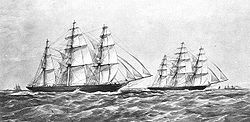 Ariel and Taeping in The Great Tea Race of 1866 | |
| History | |
|---|---|
| Name | Ariel |
| Builder | Robert Steele & Co., Greenock |
| Launched | 1865 |
| Fate | Foundered 1872 |
| General characteristics | |
| Type | Clipper |
| Tonnage | 852.87 NRT [1] |
| Length | 197.4 ft (60.2 m) [1] |
| Beam | 33.9 ft (10.3 m) [1] |
| Depth | 21 ft (6.4 m) [1] |
Ariel was a clipper ship famous for making fast voyages between China and England in the late 1860s. She is most famous for almost winning The Great Tea Race of 1866, an unofficial race between Fuzhou, China and London with the first tea crop of the 1866 season.
